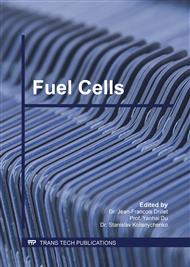p.297
p.303
p.309
p.314
p.322
p.327
p.335
p.343
p.347
Facile Fabrication of Bimetallic PtCo Nanoparticles Supported on Three-Dimensional Reduced Graphene Oxide by Ultrasonic-Assisted Method for Oxygen Reduction Reaction
Abstract:
High platinum requirements in electrocatalyst bring about huge expenditure, which hinders the commercialization and wide adoption of proton electrolyte membrane fuel cells (PEMFCs). Therefore, developing new fuel cell catalysts with excellent oxygen reduction reaction (ORR) performance may be a potential way to solve this drawback. In this paper, a facile ultrasonic-assisted method is introduced to synthesize bimetallic PtCo nanoparticles supported on three-dimensional reduced graphene oxide (Pt-Co/3DrGO). Results indicate that PtCo nanoparticles with alloy structure, small size (12.4 nm), and uniform distribution are well-dispersed onto rGO sheets. With 3D porous structure, the fabricated Pt-Co/3DrGO catalyst exhibits better ORR activity and long-term stability than that of commercial Pt/C (20 wt%). The increased electrocatalytic activity is attributed to the formation of 3D porous structure together with the effective surface structure and the highly uniform distribution of the PtCo alloy nanoparticles on rGO sheets.
Info:
Periodical:
Pages:
322-326
Citation:
Online since:
January 2017
Keywords:
Price:
Сopyright:
© 2017 Trans Tech Publications Ltd. All Rights Reserved
Share:
Citation:



